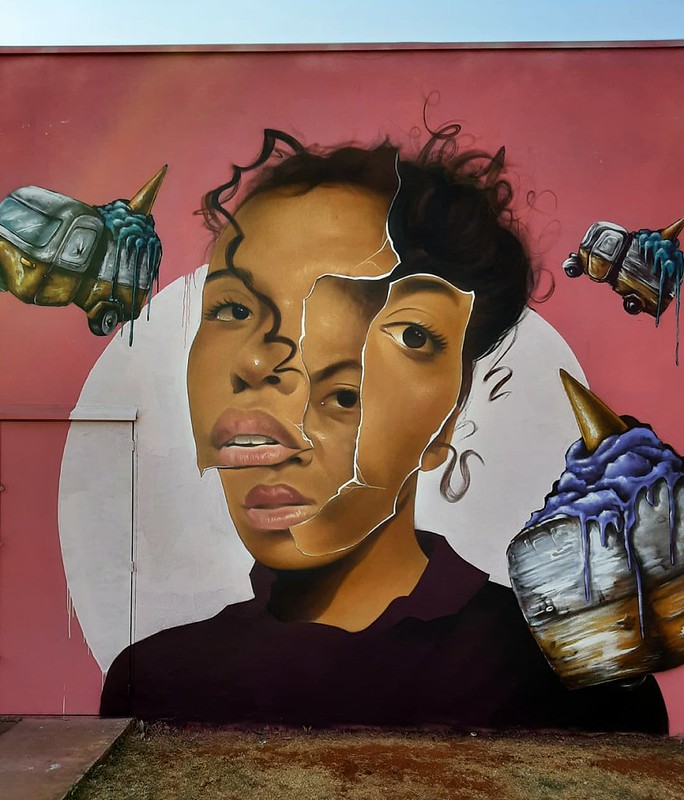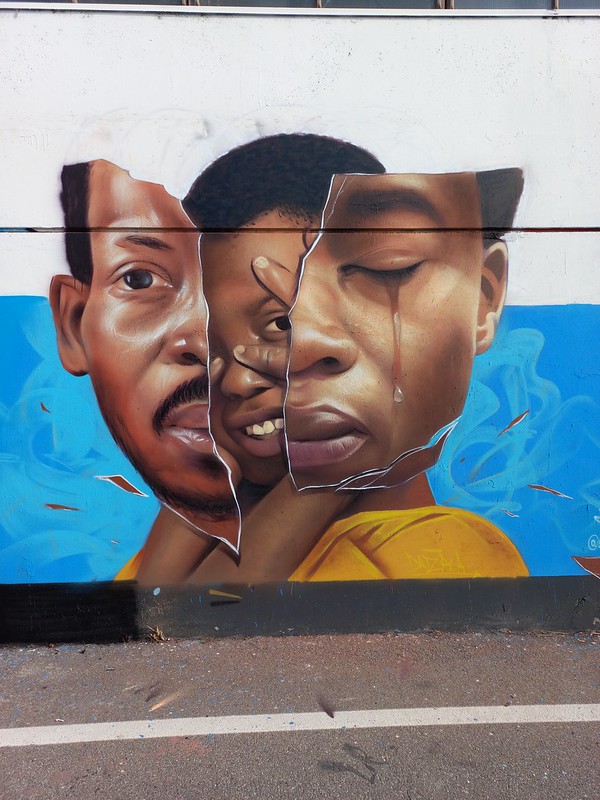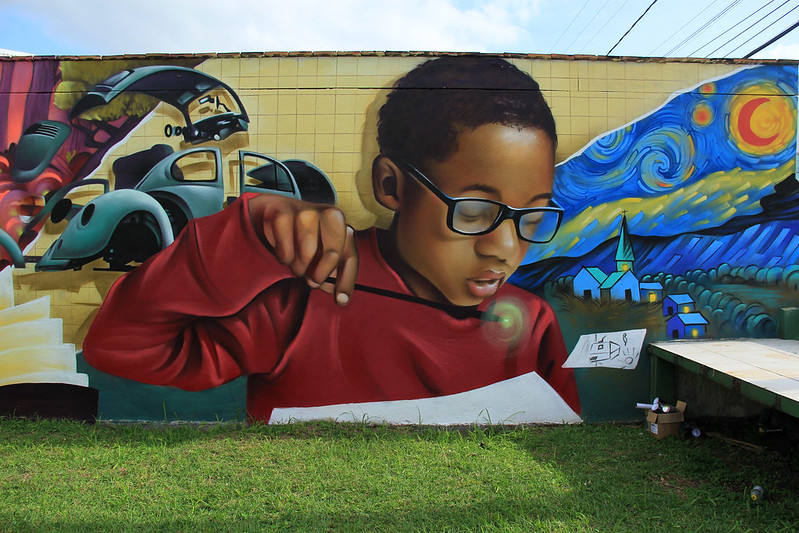Seth Dazrua
Curitiba (Brasil)
¿De dónde viene tu apodo?
Where does your pseudonym come from?
Trataba de buscar un buen apodo, estuve pensando en nombres que me iban a proporcionar letras con un buen movimiento, más fáciles de diseñar. En ese periodo tuve muchos apodos, como Magoo y 100regras, pero no me gustaban porque eran nomes muy grandes y no quedaban bien.
En ese proceso siempre fui un niño que pasaba mucho tiempo viendo revistas de Graffiti, copiando los dibujos de Graffiti y buscando un buen nombre. Así que descubrí que había artistas de Graffiti de Nova York que cuando iban hacer Graffiti dejaban el número de su casa para que las personas identificasen donde el era, y eso de tener un nombre con una referencia de numero fue una cosa que captó mi atención.
Entonces ya con ese deseo de tener un nombre con una referencia de número, un día, cuando fui a la iglesia con mi mamá, el pastor dijó que el numero 7 era el número de la perfección de Dios, y ahí decidí que el número siete seria la base para mi apodo.
Pero en portugués, 7 escrito se queda sete, y aun no me parecía un apodo suficiente al que yo quería pasar, porque para mi el Graffiti tenía que ser siempre muy original, entonces decidí hacer alguna adaptación que permitiese eso.
Ya el complemento Dazrua viene de mi crew, que es mi familia de la calle. La crew Dazrua no tiene artistas solamente de Graffiti, como también muchas otras áreas, como música, y también mantienen muchos proyectos y iniciativas increíbles.
I was trying to find a good nickname, I was thinking about names that were going to give me letters with a good movement, easier to design. In that period I had a lot of tags name, like Magoo and 100regras, but I didn’t like them because they were too big and they didn’t look good.
In that process I was always a kid who spent a lot of time looking at Graffiti magazines, copying Graffiti drawings and looking for a good name. So I discovered that there were Graffiti artists from New York that when they would do Graffiti they would leave their house number for people to identify where they were from, and that having a name with a number reference was one thing that caught my attention.
So with that desire to have a name with a number reference, one day, when I went to church with my mum, the pastor said that the number 7 was the number of God’s perfection, and that’s when I decided that the number seven would be the basis for my nickname.
But in Portuguese, 7 is written sete, and it still didn’t seem like a good enough nickname for me to go by, because for me Graffiti always had to be very original, so I decided to make some adaptation that would allow that.
The complement Dazrua comes from my crew, which is my street family. The Dazrua crew has not only Graffiti artists, but also many other areas, such as music, and they also maintain many incredible projects and initiatives.

¿Qué te motivó para empezar a pintar?
What motivated you to get started painting?
Yo siempre diseñe desde niño, esa era mi mayor distracción de mi vida que era muy difícil, pobre y sin muchas opciones. Ahí me quedaba diseñando todo el tiempo, ojeando revistas de Graffiti y intentando replicar lo que veía.
Por tener esas referencias de Graffiti, siempre quisé hacer lo mismo que hacían mis referencias, pero no me veía haciendo. Eso principalmente porque no tenía mucha referencia en mi ciudad, y los materiales eran muy caros e incompatibles con mi realidad.
Con 11 años yo comencé a bailar break junto a mi hermano y conocí otras personas que también lo hacían. Así, me acerqué al movimiento hip hop, y siempre estaba por la calle bailando, escuchando música y conociendo personas con los mismos intereses que yo.
Pero con 16 años me dispararon en mi pierna y ya no pude bailar más, eso destruyo mi sueño de bailar break.
Después de esa situación, fui alumno de un proyecto organizado por el movimiento llamado Hip Hop Organizado Brasil, del estado de Ceará, que buscaba dar cursos que iban a ayudar profesionalmente jóvenes interesados en Hip Hop.
En ese proyecto había 2 días de clases de administración de empresas, 2 días de clases de música (rap), y dos días de clases de serigrafía para los jóvenes que, así como yo, les encantaba el arte. Allí tuve un maestro llamado Julião, que tenía un grupo de rap, vio mis dibujos y comenzó a insistir en mi y a animarme a hacer Graffiti. Así yo comencé y aquí estoy hasta hoy.
I always designed since I was a kid, that was my biggest distraction from my life which was very difficult, poor and without many options. There I was designing all the time, looking through Graffiti magazines and trying to replicate what I saw.
Because I had those Graffiti references, I always wanted to do what my references were doing, but I couldn’t see myself doing it. That was mainly because I didn’t have many references in my city, and the materials were very expensive and incompatible with my reality.
When I was 11 years old, I started break dancing with my brother and I met other people who also did it. So, I got close to the hip hop movement, and I was always in the streets dancing, listening to music and meeting people with the same interests as me.
But when I was 16 years old I was shot in my leg and I couldn’t dance anymore, that destroyed my dream of break dancing.
After that situation, I was a student of a project organised by the movement called Hip Hop Organizado Brasil, from the state of Ceará, which aimed to give courses that were going to help professionally young people interested in Hip Hop.
In that project there were 2 days of business administration classes, 2 days of music classes (rap), and 2 days of screen printing classes for young people who, like me, loved art. There I had a teacher called Julião, who had a rap group, he saw my drawings and started to insist on me and to encourage me to do Graffiti. That’s how I started and here I am to this day.

¿Cuál es tu estilo?
What is your style?
Cuando empecé, cuando era apenas un niño dibujando en casa, mi referencia era el Graffiti letras, principalmente el trabajo de los artistas Does y Binho que hacían Wild Style. Así, yo quería hacer como ellos y ser un artista de ese estilo, haciendo unas letras más agresivas y diseñadas.
Pero yo me di cuenta que no conseguía desarrollarme haciendo letras, y como yo siempre dibujé muy bien, yo empecé a hacer algunos personajes, que para mí era una cosa más fácil.
Yo empecé haciendo unos personajes de dibujos animados, pero con unos detalles realistas, ya que me encantaban trabajos de graffiti realista, pero yo no creía que algún día iba conseguir hacer algo así. Pero cuando ya dominé el spray, empecé a conseguir hacer los trazos como yo quería y dominar las técnicas, comencé a hacer trabajos cada vez mas realistas, y hoy en día soy un artista de realismos.
When I started, when I was just a kid drawing at home, my reference was Graffiti lettering, mainly the work of the artists Does and Binho who did Wild Style. So, I wanted to do like them and be an artist of that style, making more aggressive and designed letters.
But I realised that I couldn’t develop myself doing lyrics, and as I always drew very well, I started doing some characters, which was an easier thing for me.
I started doing some cartoon characters, but with realistic details, because I loved realistic graffiti work, but I didn’t think that one day I would be able to do something like that. But when I mastered the spray, I started to make the strokes as I wanted and mastered the techniques, I started to do more and more realistic works, and today I am a realism artist.

¿Qué piensas de la idea de publicar tus piezas con una entrevista en elrincondelasboquillas.com?
What do you think about the idea of us publishing your artworks on our web «elrincondelasboquillas.com»?
Antes pensaba que el Graffiti era una cosa solamente de la calle, pero cuando las personas empezaron a conocer mi trabajo, que personas de todo el mundo empezaron a buscarme por mi Graffiti, yo percibí que el tiene el poder de influenciar positivamente mucha gente.
Y así percibí también que cuanto más yo comparto mi historia, más gente se identifica con mi trayectoria, porque al venir de dónde vengo, muchas personas comienzan a creer que también pueden llegar a donde llegué yo.
Entonces noté que cuánto más hablo de mi vida, más gente se identifica, y por eso me siento muy contento de tener la oportunidad de hablar un poco más sobre mi trabajo, mi historia y mi arte, porque sé que llegaré en más personas y mi historia va a influenciar a más gente.
I used to think that Graffiti was just a street thing, but when people started to know my work, when people from all over the world started to look for me because of my Graffiti, I realised that it has the power to positively influence a lot of people.
And so I also noticed that the more I share my story, the more people identify with my trajectory, because coming from where I come from, many people start to believe that they can also get to where I got to.
So I noticed that the more I talk about my life, the more people identify, and that’s why I’m very happy to have the opportunity to talk a little bit more about my work, my story and my art, because I know that I will reach more people and my story will influence more people.

¿Te acuerdas de la primera pieza?
Do you remember the first piece?
Mi primer Graffiti fue en el estilo de letras, diferente de lo que hago hoy que es en estilo realista. Me acuerdo que era una sensación increíble, no sabía muy bien, no tenía curso, mi maestro fue la calle, tampoco sabía como hacerlo, pero solo quería expresarme. Yo sentía que estaba enfrentando a todo el mundo y a mí mismo. Fue en un muro en el barrio que crecí, Uberaba, en el estado Curitiba/Paraná, Brasil.
Me acuerdo de que sin técnica, sin saber cómo hacer, yo tenía muchas ganas de expresar mi arte.
My first Graffiti was in the lettering style, different from what I do today which is in a realistic style. I remember it was an incredible feeling, I didn’t know very well, I didn’t have a course, my teacher was the street, I didn’t know how to do it either, but I just wanted to express myself. I felt that I was confronting the whole world and myself. It was on a wall in the neighbourhood where I grew up, Uberaba, in the state of Curitiba/Paraná, Brazil.
I remember that without technique, without knowing how to do it, I really wanted to express my art.

Y para terminar ¿algo que quieras decir?
And finally, anything you want to say?
Yo quería mucho agradecer la oportunidad de poder llevar mi trabajo y mi arte para las personas, así como un día ver artistas, su historia y su trabajo en revistas fue mi manera de tener referencias de Graffiti.
I was very grateful for the opportunity to be able to bring my work and my art to people, as one day seeing artists, their history and their work in magazines was my way of getting references to Graffiti.




